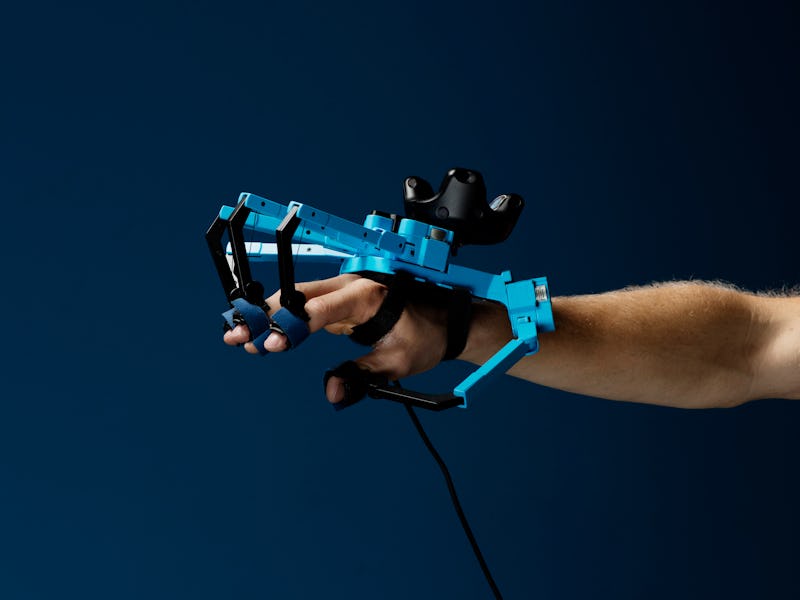30 years later, Nintendo's weirdest hardware flop could finally catch on
Today, haptic gloves could spice up the Metaverse.

The year was 1989, and Nintendo had just released a groundbreaking game controller that could throw players into the action as no accessory had before.
The now-infamous Power Glove looked a bit like the kind of protective equipment worn to handle hazardous materials, but it was revolutionary at the time: The device allowed players to control games using the movement of their bodies without the need for a hand-powered controller.
Unfortunately, a combination of limited game options and its clunky design made it impossible for the gizmo to reach its full potential.
The Nintendo Power Glove was ahead of its time — but the device wasn’t able to reach its full potential.
While the Power Glove may be dead, the dream of bringing users into virtual environments with easy-to-integrate accessories like gloves lives on, says Ben O’Brien, CEO of the motion-capture technology company StretchSense.
“Being able to reach out and simply touch and manipulate virtual environments significantly lowers the learning curve and makes virtual worlds as accessible as possible,” O’Brien says. “This accessibility is essential as more and more of how we work, play, create, learn, and socialize goes online.”
The VR glove makes a comeback
SenseGlove’s Nova model costs $5,000, so it isn’t exactly appealing to most consumers.
Tech companies have tried to convince consumers to embrace virtual reality for decades. Nowadays, it helps that the main VR tool, a goggle-like headset, has become increasingly slimmer, cheaper, and overall more accessible for consumers.
While VR hasn’t yet fully infiltrated the entertainment world or dominated our social interactions, the developers behind projects like Meta’s Metaverse — an immersive virtual reality world not unlike its early 2000s counterpart Second Life — hope that will soon be the case.
In addition to supporting virtual community spaces, O’Brien says that VR technology like gloves could help prepare the many workers forced to shift careers during the pandemic.
VR training can benefit people entering a wide range of fields, like incoming medical professionals, skilled manufacturing workers, pilots, and crane operators, he explains. “People learn best with immersion and when they can make mistakes — in real life this is often not possible due to financial, logistical, or safety reasons, which greatly slows down learning.”
Nowadays, StretchSense is one of many companies and research groups working to perfect VR gloves. Moving forward, these tools should include a few key features, according to O’Brien:
- The ideal glove is soft, comfortable, and doesn’t interfere with movement
- It precisely tracks the motion of hands and fingers using flexible sensors
- The glove can stand up to a real-world beating (e.g. spilled coffee, washing, accidental drops)
- It can integrate well with existing headsets and VR systems
When can you buy VR gloves?
The VR glove from the Manufhaptics project will include artificial muscles.
Of course, these are some pretty idealistic features that likely won’t be possible in the short term. But tech companies aren’t starting from scratch.
For example, the video game industry has already incorporated haptic feedback into controllers to make them vibrate — VR gloves also need to provide this sort of effect to create the sensation of touch. For example, if you grab a ball in a VR game, the glove should provide a certain amount of pressure and weight to your real hand to simulate the action.
To create this effect in VR, glove designers are playing with a number of features. These include inflating air pockets proposed by Meta and the start-up HaptX, as well as 3D-printed “muscles” from the European research collaboration Manufhaptics.
Part of what makes Manufhaptics’ VR glove concept possible is a lotion-like electroactive polymer that can be used to churn out artificial muscles, says Dorina Opris, head of the collaboration’s functional Polymeric Materials research group.
This electroactive “cream” could hold the key to better VR gloves.
“One of the significant advantages of our elastomers produced from the ‘cream’ is that they respond to lower voltages than other existing materials,” Opris says. “Devices operated at low voltages are safer, cheaper, and allow for more applications.”
You can already buy some relatively advanced VR gloves, like SenseGlove’s Nova model — if you have $5,000 sitting around — but even the most expensive products can’t yet offer realistic sensations. Better gloves are largely being toiled over in private, but O’Brien says that could soon change.
Advanced gloves could become available to consumers over the next three to five years as technology improves, he says. StretchSense aims to launch its first haptic VR glove for businesses next year and will then move on to the consumer offering.
But will the next generation of VR gloves end up like the Power Glove, collecting dust in people’s closets? Only time will tell.